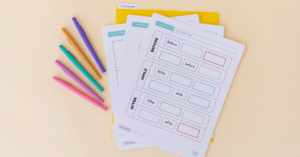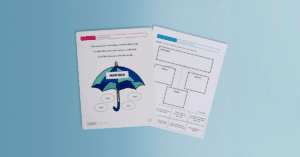Listen on Apple Podcasts Listen on Spotify
In this episode of the SLP Now Podcast, we’re talking about building your speech therapy materials library. And spoiler alert:
You don’t need a ton of materials to be an effective SLP!
In fact, sometimes less is more — which is what Marisha learned when she had to move away from a very well-stocked speech room to a very sparsely stocked speech room. She was apprehensive about losing access to her beloved materials, but ultimately, having less to work with made her a more effective clinician.
Marisha took to the podcast to share her story about finding more with less, and, her top three therapy essentials for SLPs creating a well-rounded materials library. 👇
Three Therapy Essentials Every SLP Needs:
1. Probes for Assessment:
Probes are quick assessments that allow you to monitor student progress on specific goals. Having a clear way to measure progress for each goal is crucial for effective therapy.
2. Visuals or Teaching Materials
Marisha emphasizes the importance of having visuals or teaching materials for each goal. Whether it’s articulation placements, cheat sheets, or other resources, they’re essential for teaching skills effectively.
3. Therapy Units for Practice
If you’ve been following SLP Now for a while, you know that Marisha is a huge advocate for embedded practice, basing units on books, science experiments, or the curriculum. Choosing rich activities that are relevant increases their effectiveness, and offers multiple opportunities or contexts to target various language goals.
Feeling overwhelmed by the prospect revamping your routine?
Take a deep breath, and remember that you can start small.
Marisha recommends that you pick one group, and start with one student. Gather assessments and visuals for their goals, and find a suitable unit to support the targets. Then, rinse and repeat.
It’s okay to take baby steps to build your materials library. Work gradually, and make meaningful progress instead of trying to fill your space with all the things you think you need — because keeping it simple can save you so much time, energy, and sanity. 🙏
Assess. Teach. Practice.
And remember: You are your best therapy tool.
Links Mentioned:
How to Structure a Speech Session
🔍 Searching for Low-Prep, Evidence-Backed Therapy Units? 🔎
The SLP Now membership offers a library of 4,000+ materials — including assessment and teaching tools — and 400+ therapy plans, making it easier for SLPs to find the right materials and resources.
Whether you’re a digital diva or a lamination queen, SLP Now has you covered with activities, visuals, data collection tools, and more.
Learn more about SLP Now, or start your free 14 day trial today! Your first 5 downloads are free!
Subscribe
Subscribe to the SLP Now podcast and stay tuned for our next series. We’re kicking off September by helping you get your data collection, paperwork, and therapy planning processes in tip-top shape! 💪
Listen to The SLP Now Podcast on Apple ★ Spotify ★ Google ★ Stitcher ★ Castbox or wherever you listen to podcasts.
Transcript
Marisha :
Hey there and welcome back. Today we get to chat about building your speech therapy materials library, and I have three essentials that you'll want to build out your library. And this is coming from an SLP who moved to a new school out of state. The move was a little bit chaotic and I didn't move all of my stuff with me right away, and I went into a very minimal speech therapy room. And so I got to learn how to do speech therapy without a ton of materials, and it was so nice. I had come from a speech therapy room that was filled, and I'm not ungrateful for it. It was really nice to have access to a lot of different resources, but it's also a little bit overwhelming and it's like walking into a closet where you feel like you have nothing to wear because there's just too many options. So having a really streamlined set of materials was really, really nice for me, and I got to really focus on the essentials. So without further ado, let's dive into those three essentials.
We've talked about this on the podcast already, but the first essential is our probes. Just in case you're not familiar, a probe is just a quick assessment that you can use to monitor your student's progress on a goal. And a probe is meant to be given without support, and we're just seeing how the student is doing on that skill without support. And we want to make sure that we, whether you call it a probe or something else, we want to make sure that we have a way to measure every goal that we write for students. So that should be a process of when we're writing an IEP, any goal that we add, we should have a very clear way to measure that goal. Whether it's a rubric or a little probe or whatever it might be, we want to be really clear on how we're measuring progress towards that goal. So that is our first essential, is making sure that we have all of our probes.
Our second essential is visuals or teaching materials. So I like to go through all of my students' goals, and again, I like to make sure that I have a probe or a way to assess each goal. And then I also want to make sure that I have a visual or a way to teach that skill to each student. So for an articulation goal, I might have some placement visuals, and then I might also have some, whether it's in my brain or on a cheat sheet or a piece of paper, elicitation strategies for that sound, maybe facilitative concepts. Whatever will help me teach that skill to the student, I want to make sure that I have those resources. So far, we have a way to assess, and then we also have a way to teach the skills. And if you listen to the podcast on how to structure a session, this might sound a little familiar because the heart of your speech therapy session is assess, teach, practice. So we have tools to assess, tools to teach.
And then the third one, the core of a therapy session is practice, and so then we need materials to practice skills. And what this looks like for me are therapy units. I am a huge fan of embedded practice. There's a lot of research supporting the use of literacy based therapy in just functional contexts to target our students' skills. So I like to use a lot of books. I do science experiments. I have vocational videos that I like to use with students working on more functional language like ordering food at a restaurant, for example. So those are the types of units that I like to use. And one, they're very relevant for my students, and then they also are language-rich, and I'm able to target all of my students' goals using those language-rich activities.
And a lot of the podcast episodes in the archive will have more of those therapy strategies, but just to recap the core materials that we want to have, so we want to have our assessment tools. We want to have the tools that we're using to teach skills. And for me, this is typically some visuals. And then our third essential is to have our therapy units, so whether they're book units, article units, whatever that might look like. And the cool thing is that SLP Now has a library of over 4,000 materials, and you can easily find all of the assessment tools in one place, all of your teaching tools in one place.
And for the therapy units, we have a whole therapy plans feature. We have over 400 therapy plans where you can filter for it by a specific group or a specific type of unit, and then it'll give you all of your activity ideas, and then it'll also give you supplementary materials. There's digital versions so that you can click and go if you don't have time to prep, but you can also access materials if you want to print and/or laminate anything to use in your sessions. SLP Now is not required to implement this. I've built my own probes by just writing the questions on a piece of paper and putting it in a binder or adding it to my student's goal card. It doesn't have to be anything fancy, but if you are feeling overwhelmed starting to navigate this, or what visuals would I use? Or how do I build my cheat sheet for how to teach basic concepts? Or how do I put together a book unit? or whatever it might look like, SLP Now has all of those resources ready to go and organized for you.
So yeah, those are our three essentials and what it looks like, and I would recommend, if you're feeling overwhelmed, maybe just pick one student and then maybe pick one group to start with. Start with one student, graph assessments and visuals for their goals, and then repeat for each student in the group, and then try and find a unit that would work well for them. And then just rinse and repeat, but taking baby steps is the best way to do things. I think that's the only way to really make meaningful progress, so just start small and start building those materials. And especially if you listen to episode 158 on structuring a therapy session, you can see how much easier your sessions will feel and how much less prep and planning you'll have to do with a really simple system. So I hope that this little recap was really helpful. Do let us know if you have any questions, and we'll see you in the next episode. Hope you have a fabulous week.
Sign up to receive email updates
Enter your name and email address below and I'll send you periodic updates about the podcast.




Reader Interactions